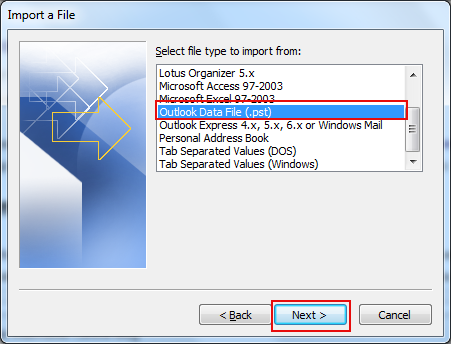

- #Importing a pst file to outlook for mac archive#
- #Importing a pst file to outlook for mac full#
- #Importing a pst file to outlook for mac license#
- #Importing a pst file to outlook for mac download#
#Importing a pst file to outlook for mac archive#
The next command you can use is aimed at importing the PST file into the users’ archive mailbox: It imports the PST file from the server EX2016A and adds it to a target folder, “PSTImport.” New-MailboxImportRequest -Mailbox User1 -FilePath \\EX2016A\PSTFiles\User1.pst -TargetRootFolder "PSTImport" Here is one of a few PowerShell commands you can run, the first being the target folder. Once this has been completed, and replication is complete in the environment, you can now proceed with the mailbox imports. By default, the mailbox import-export role does not have any assigned role groups. This can be to the following locations:īefore you can perform imports of PST files, you need to ensure that you have the correct permissions in Exchange to do so. When the copy is done, you have to make a decision on where you want to import the PST files. Once you have completed that, you can now copy over the PST files from users’ machines and, since they will most likely have the email address as the PST name, it is easily identifiable.
#Importing a pst file to outlook for mac full#
Then, under advanced sharing, add the Exchange Trusted Subsystem with full access. Or, if you have a dedicated server used only for mail flow, you can create a folder called PST or PSTFiles, which you need to share. In your environment, it might be a file server, or if you only have a small handful of PST files, you can also create it on your Exchange Server.
#Importing a pst file to outlook for mac license#
(Be aware that to enable archiving in Exchange, you need an Enterprise client access license (CAL) for the user.)įor the two methods of importing PST files we just mentioned, we need to create a shared folder with rights that the Exchange Trusted Subsystem can access the files with no issue. We will be taking a look at the two methods of importing PST files - with 1) Exchange Management Shell (EMS) and Exchange admin center, and 2) with Outlook. The same goes for if you have a dedicated Exchange Server store that is used for archive mailboxes - they can be imported there or the users can import the PST file to the archive mailbox that will be available to them in Outlook. Mimecast, for example, will send you an encrypted drive that you can copy all the company PST files to, and they then will bring that mail into your archive, so you always have it available. With many companies moving mail from on-premises servers to the cloud, PST files can be ingested and taken off users’ machines. Many use PST files as a backup, and when they get too large, they end up corrupting, or you cannot open Outlook because of errors with the PST file. But if you are new to Exchange and PST files, what are they? It is a personal storage table that you have attached to Microsoft Outlook and allows you to create folder structures and drag-and-drop email from your mailbox to the PST file. To remove the PST Import Tool for Entourage, drag it to the Trash.PST files are nothing new to IT admins as they have been around for years. The PST Import Tool for Entourage does not include an uninstall feature. Follow the steps in the PST Import Tool wizard.On the desktop, double-click the PST Import Tool program to start the import process.Drag the PST Import Tool program and the Documentation folder from the PST Import Tool volume to your desktop.This step may have been performed for you. Open the PST Import Tool volume on your desktop.If it does not, on your hard disk, double-click the file that you downloaded in step 4 to expand it. In most Web browsers, the file you downloaded expands automatically.
#Importing a pst file to outlook for mac download#
(To check your preferences, on the Explorer menu, click Preferences, and then click Download Options in the left pane). If you are using Internet Explorer, the Download Manager saves the file to the desktop unless you specified a different folder in the Preferences dialog box of Internet Explorer. (To check your preferences, on the Safari menu, click Preferences, and then click General.) If you are using Safari, the file is downloaded to the desktop unless you specified a different folder in the Preferences dialog box of Safari. Follow the instructions on the screen to save the file to your hard disk.Make sure your computer meets the minimum system requirements.



 0 kommentar(er)
0 kommentar(er)
